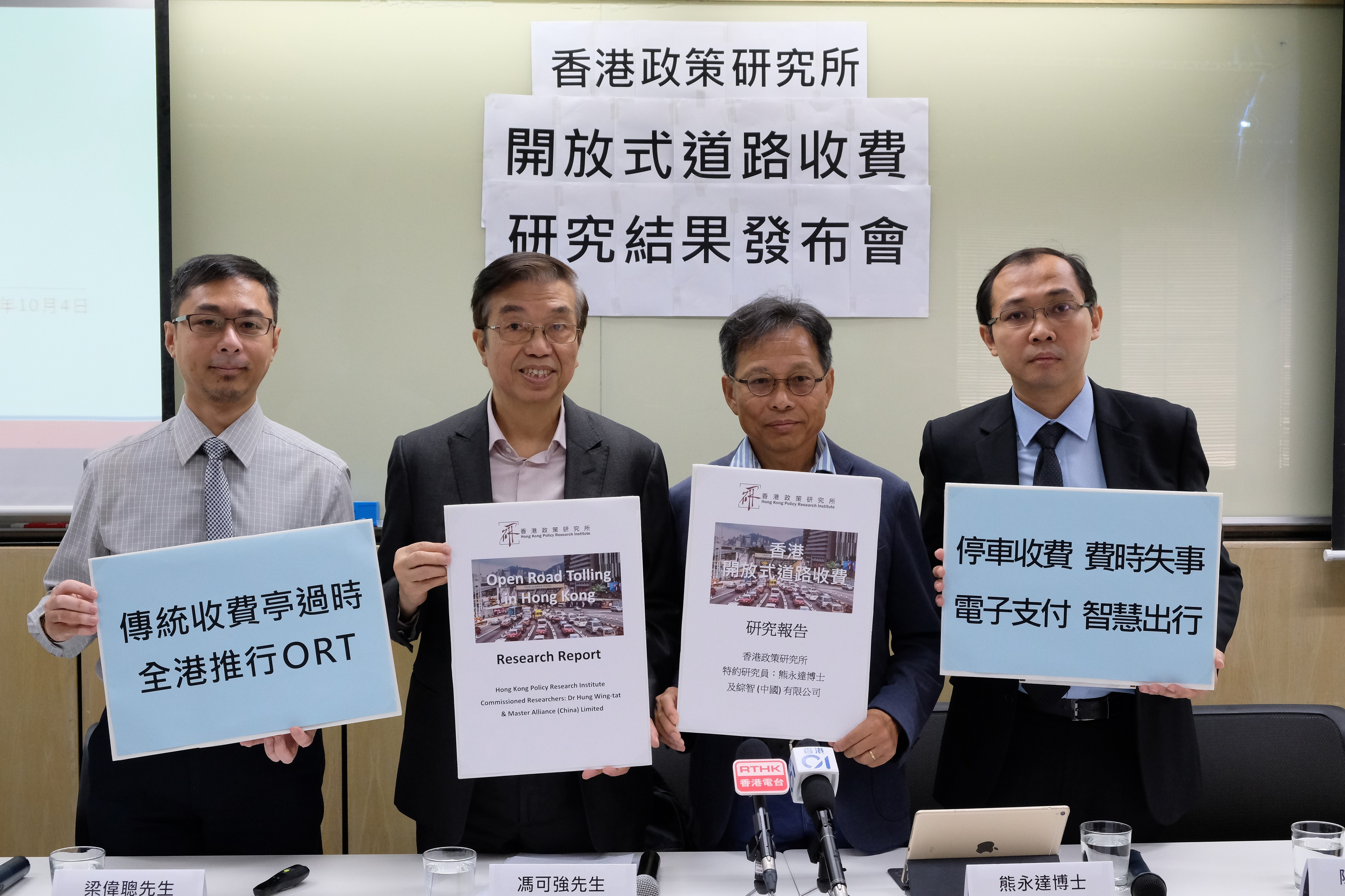
香港政策研究所董事暨行政總監馮可強(左二)、香港運輸研究學會資深會員熊永達博士(右二)及研究團隊成員梁偉聰(左一)及陳文傑(右一)。
1. Study Objective
1.1 This study on open road tolling (named ORT thereafter) is conducted to support the realization of Smart Mobility which is an essential component of the Chief Executive’s “Smart City” initiatives launched in 2017.
2. Study Methodology
2.1 The study was carried out through three methods, i.e., i) a Statistical Analysis of the vehicle passing the toll points to understand the usage pattern of various users at road toll points; b) a Literature Review to understand the prevailing ORT systems and c) a Stated Preference Survey to identify the local toll road users’ expectations and acceptability of prevailing ORT systems. A total of 1,106 drivers were interviewed; 974 out of the 1,106 records were valid.
3. Results
3.1 There were around 248 million vehicles 1 each year passing through the studied 9 road toll points in 2016 and 2017. These trips are stable throughout the year with a small decrease in the summer months. Buses, light buses and taxis made a lot more trips through the toll points than private cars. The percentage of using “stop-and-go” payment method and “auto-toll” is 51% and 49%; 83% of buses, 98% public light buses and 70% of the medium & heavy goods vehicles but only 5% of taxis used auto-toll.
3.2 Open Road Tolling (ORT) has been widely adopted worldwide as an essential initiative towards smart mobility. The major benefits of ORT system are:
3.2.1 drivers saves time to stop to pay especially in the non-peak hours;
3.2.2 road safety will be drastically improved through reducing the vehicles’ weaving movements in lane searching;
3.2.3 the land required for the toll plazas will be significantly reduced and thus can be released to meet other pressing needs; and
3.2.4 the vehicle fuel consumption and exhaust emissions will be reduced owing to less vehicle stopping and starting movements.
3.3 Three prevailing technologies are adopted in Asia, Europe and America, namely Dedicated Short-range Communications (DSRC), Global Navigation Satellite System (GNSS) and the Automatic Number Plate Recognition (ANPR). Out of the twenty worldwide ORT systems reviewed, all nearby Asian countries including China, Japan, South Korea, India and Singapore employ DSRC/ RFID system. DSRC and GNSS require an in-vehicle unit and their accuracy is over and around 99% while ANPR does not require an in-vehicle unit and its accuracy is around 90%.
3.4 The majority of toll road users (75%) agreed to adopt ORT in Hong Kong. It is obvious that the drivers have high expectations that the ORT system can save their trouble and time in weaving, queuing, stopping and paying tolls and the same ORT system extended to other infrastructure charging will make life easier without managing various charging regimes for different facilities. However, they expressed the following concerns (in the order of importance):
3.4.1 administration fee;
3.4.2 personal data privacy;
3.4.3 responsibility of in-vehicle maintenance; and
3.4.4 level of inconvenience.
3.5 Most drivers (59.4%) preferred the Transport Department to be responsible for handling personal data. And most toll road users (58.4%) agreed converting the paper vehicle license issued by the Transport Department to in-vehicle unit (smart card/tag) of the ORT system. The absolute majority of drivers prefer cashless payment, either by credit or debit cards but a bit favour on debit card.
3.6 DSRC assisted with ANPR to ensure toll enforcement has been employed by auto-toll locally for years and about 50% of the vehicle fleet passing the toll points has an in-vehicle unit. Local user has been familiar with the technology. GNSS tracks vehicles and thus facilitates area-based, time-based or distancebased road charging as well as vehicle fleet management. It however needs instant data transmission service through internet, generating concerns of extra running fee. As GNSS tracks vehicles, it may trigger bigger personal data concerns than DSRC especially for private car drivers.
4. RECOMMENDATIONS
4.1 Government to implement a territorial-wide ORT system
4.1.1 To push ahead the initiative of Smart Mobility stipulated in the 2017 Smart City Blueprint of the Chief Executive, the Government should implement a territorial-wide ORT system which will improve the traffic flow efficiency and enhance convenience to toll road users as well as improve road safety and reduce fuel consumption and exhaust emissions. Assuming each vehicle must stop for one minute to pay the road toll and currently around 50% of vehicles use stop-and-go payment, the total time saving for 50% of the annual 248,008,937 transactions2 will be about 124 million minutes per year. Taking the time value of toll road user as HK$1.0/minute, the money saved is 124 million per year. Public transports including bus, minibus and taxi which made greater numbers of daily trips through toll roads (public light bus: 14.9; bus: 7.9; taxi: 6.6) will enjoy more significant benefits.
4.1.2 The Transport Department or a Government appointed operator to be bounded by Government’s strict regulations and contract terms should operate the territorial-wide ORT system to allay the toll road users’ concerns of administrative fee, personal data security, responsibility of maintaining the in-vehicle unit and inconvenience in using the ORT system. As such, the track records of relevant experience of the potential operator in addressing local customers’ concerns mentioned above are of vital importance.
4.1.3 The territorial ORT system should not only be limited to toll road application; it should be extended to paying other transport infrastructure facilities such car parking. The wider application of ORT system should be further studied.
4.2 The technology to be adopted
4.2.1 As adverse weather conditions with low visibility are common in Hong Kong, the accuracy (or capture rate) of ORT system employing automatic number plate recognition (ANPR) technology is limited, leading to toll enforcement difficulty which should not be considered. The ORT system employing the dedicated short-range communications (DSRC) assisted with ANPR is the best potential system as it has been practiced in Hong Kong and does not trigger extra concerns of personal data privacy and additional administration fee compared to the global navigation satellite system (GNSS) technology.
4.2.2 To expedite the implementation of this territorial-wide ORT system, the Government should consider upgrading the paper format vehicle license to a smart card/tag format so that it can serve as an in-vehicle unit of the ORT system. The feasibility of this conversion should be further studied.
4.2.3 The GNSS technology has an advantage of wider applications such as vehicle fleet management, area-based; time-based or distance-based road charging. In case of testing the applicability of this technology in Hong Kong, the Government should formulate measures to allay concerns of administration fee, personal data handling as well as responsibility of in-vehicle maintenance and level of inconvenience of the toll road users.

